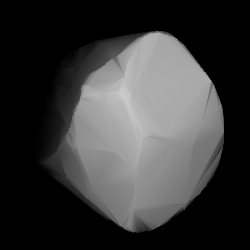Astronomy:154 Bertha
 | |
| Discovery[1] | |
|---|---|
| Discovered by | P. M. Henry |
| Discovery date | 4 November 1875 |
| Designations | |
| (154) Bertha | |
| Pronunciation | /ˈbɜːrθə/[2] |
| A875 VD | |
| Minor planet category | Main belt |
| Orbital characteristics[3][4] | |
| Epoch 31 July 2016 (JD 2457600.5) | |
| Uncertainty parameter 0 | |
| Observation arc | 130.75 yr (47758 d) |
| |{{{apsis}}}|helion}} | 3.44 astronomical unit|AU (515.21 Gm) |
| |{{{apsis}}}|helion}} | 2.95 AU (441.30 Gm) |
| 3.20 AU (478.26 Gm) | |
| Eccentricity | 0.077261 |
| Orbital period | 5.72 years (2,087.9 d) |
| Average Orbital speed | 16.63 km/s |
| Mean anomaly | 125.046° |
| Mean motion | 0° 10m 20.734s / day |
| Inclination | 20.9724° |
| Longitude of ascending node | 36.7441° |
| 159.722° | |
| Earth MOID | 1.95 AU (291.94 Gm) |
| Jupiter MOID | 1.53 AU (229.03 Gm) |
| TJupiter | 3.087 |
| Physical characteristics | |
| Dimensions | 184.93±3.6 km[3] 186.85±1.83 km[5] |
| Mass | (9.19±5.20)×1018 kg[5] |
| Mean density | 2.69±1.52 g/cm3[5] |
Equatorial surface gravity | 0.0517 m/s² |
Equatorial escape velocity | 0.0978 km/s |
| Rotation period | 25.224 h (1.0510 d)[3][6] |
| Geometric albedo | 0.0480±0.002[3] 0.0483 ± 0.0107[7] |
| Physics | ~156 K |
| C[7] | |
| Absolute magnitude (H) | 7.58,[3] 7.530[7] |
Bertha (minor planet designation: 154 Bertha) is a main-belt asteroid. It was discovered by the French brothers Paul Henry and Prosper Henry on 4 November 1875, but the credit for the discovery was given to Prosper. It is probably named after Berthe Martin-Flammarion, sister of the astronomer Camille Flammarion.[8]
Observations performed at the Palmer Divide Observatory in Colorado Springs, Colorado in during 2007 produced a light curve with a period of 22.30 ± 0.03 hours and a brightness range of 0.10 ± 0.02 in magnitude. A 1998 measurement gave a value of 27.6 hours, which doesn't fit the PDO data.[9] In 2011, observations from the Organ Mesa Observatory in Las Cruces, New Mexico were used to determine a rotation period of 25.224 ± 0.002 hours with a brightness variability of 0.10 ± 0.01 magnitude, ruling out previous studies.[6]
This is classified as a C-type asteroid[7] and it has an estimated diameter of about 187 km.[5]
References
- ↑ "Discovery Circumstances: Numbered Minor Planets". International Astronomical Union - Minor Planet Center. https://minorplanetcenter.net//iau/lists/NumberedMPs000001.html.
- ↑ Bertha (3rd ed.), Oxford University Press, September 2005, http://oed.com/search?searchType=dictionary&q=Bertha (Subscription or UK public library membership required.)
- ↑ 3.0 3.1 3.2 3.3 3.4 Yeomans, Donald K., "154 Bertha", JPL Small-Body Database Browser (NASA Jet Propulsion Laboratory), https://ssd.jpl.nasa.gov/sbdb.cgi?sstr=154, retrieved 12 May 2016.
- ↑ "The Asteroid Orbital Elements Database". Lowell Observatory. http://ftp.lowell.edu/pub/elgb/astorb.html.
- ↑ 5.0 5.1 5.2 5.3 Carry, B. (December 2012), "Density of asteroids", Planetary and Space Science 73: pp. 98–118, doi:10.1016/j.pss.2012.03.009, Bibcode: 2012P&SS...73...98C. See Table 1.
- ↑ 6.0 6.1 Pilcher, Frederick (April 2012), "Rotation Period Determinations for 31 Euphrosyne, 65 Cybele, 154 Bertha 177 Irma, 200 Dynamene, 724 Hapag, 880 Herba, and 1470 Carla", The Minor Planet Bulletin 39 (2): pp. 57–60, Bibcode: 2012MPBu...39...57P.
- ↑ 7.0 7.1 7.2 7.3 Pravec, P. et al. (May 2012), "Absolute Magnitudes of Asteroids and a Revision of Asteroid Albedo Estimates from WISE Thermal Observations", Asteroids, Comets, Meteors 2012, Proceedings of the conference held May 16–20, 2012 in Niigata, Japan (1667), Bibcode: 2012LPICo1667.6089P. See Table 4.
- ↑ Schmadel, Lutz D. (2012), Dictionary of Minor Planet Names (6th ed.), Springer, p. 27, ISBN 3642297188, https://books.google.com/books?id=aeAg1X7afOoC&pg=PA27.
- ↑ Warner, Brian D. (September 2007), "Asteroid Lightcurve Analysis at the Palmer Divide Observatory", The Minor Planet Bulletin, Bibcode: 2007MPBu...34...72W.
External links
- Lightcurve plot of 154 Bertha, Palmer Divide Observatory, B. D. Warner (2007)
- Asteroid Lightcurve Database (LCDB), query form (info )
- Dictionary of Minor Planet Names, Google books
- Asteroids and comets rotation curves, CdR – Observatoire de Genève, Raoul Behrend
- Discovery Circumstances: Numbered Minor Planets (1)-(5000) – Minor Planet Center
- 154 Bertha at AstDyS-2, Asteroids—Dynamic Site
- 154 Bertha at the JPL Small-Body Database
 |

